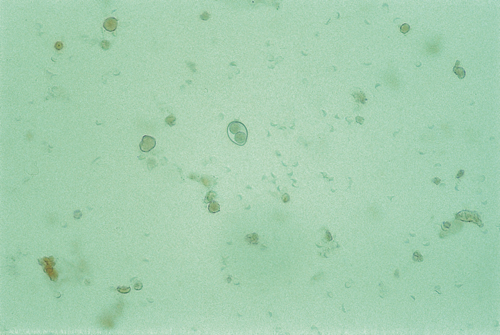Difference between revisions of "Small Animal Abdominal and Metabolic Disorders Q&A 12"
| Line 14: | Line 14: | ||
|a1= | |a1= | ||
An oocyst of ''Isospora felis''. | An oocyst of ''Isospora felis''. | ||
| − | |l1= | + | |l1= |
|q2=How would you manage this case? | |q2=How would you manage this case? | ||
|a2= | |a2= | ||
| Line 28: | Line 28: | ||
If numerous oocysts are found in the faeces, and no other cause for the clinical signs is apparent, treatment is recommended | If numerous oocysts are found in the faeces, and no other cause for the clinical signs is apparent, treatment is recommended | ||
with trimethoprim/sulphadiazine (30 mg/kg daily) or furazolidone (8 mg/kg daily), both given for 7–10 days. | with trimethoprim/sulphadiazine (30 mg/kg daily) or furazolidone (8 mg/kg daily), both given for 7–10 days. | ||
| − | |l2= | + | |l2= |
</FlashCard> | </FlashCard> | ||
Revision as of 13:20, 26 October 2011
| This question was provided by Manson Publishing as part of the OVAL Project. See more Small Animal Abdominal and Metabolic Disorders Q&A. |
A four-month-old kitten is presented with persistent diarrhoea and poor growth. The result of faecal analysis is shown.
| Question | Answer | Article | |
| Identify this parasite. | An oocyst of Isospora felis. |
[[|Link to Article]] | |
| How would you manage this case? | Infection with Isospora is extremely common, particularly in kittens. Although Isospora can be a primary pathogen, in the majority of cases a self-limiting infection occurs in the absence of any clinical signs. A heavy infection may occur, in association with overcrowding, poor hygiene and stress, and may result in diarrhoea, vomiting, weight loss or poor growth. Where Isospora is identified, it is important to search for other causes of the clinical signs (Salmonella, Campylobacter, Giardia, intussusception, etc.) as the coccidia may be an incidental finding. If numerous oocysts are found in the faeces, and no other cause for the clinical signs is apparent, treatment is recommended with trimethoprim/sulphadiazine (30 mg/kg daily) or furazolidone (8 mg/kg daily), both given for 7–10 days. |
[[|Link to Article]] | |
